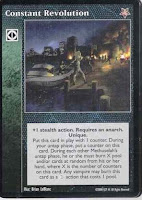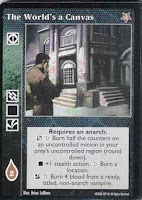 Anarch Manifesto
Anarch ManifestoAnarchist Manifesto is a work by Anselme Bellegarrigue, notable for being the first manifesto of anarchism. It was written in 1850, ten years after Pierre-Joseph Proudhon became history's first self-proclaimed anarchist with the publication of his seminal "What Is Property?".
More information:
- Anarch Manifesto on Wikipedia.
- Another Anarch Manifesto on "flag.blackend.net".
- Another Anarch Manifesto on "anarchy.net".
CrimethInc.
 "CrimethInc." is a decentralized anarchist collective composed of autonomous cells which act independently in pursuit of a freer and more joyous world. On of their mottos is "The Future is unwritten".
"CrimethInc." is a decentralized anarchist collective composed of autonomous cells which act independently in pursuit of a freer and more joyous world. On of their mottos is "The Future is unwritten"."CrimethInc." cells have variously published books, released records and organized large-scale national campaigns against globalization and representative democracy in favor of radical community organizing.
They say about themselves: "Crimethought is not any ideology or value system or lifestyle, but rather a way of challenging all ideologies and value systems and lifestyles - and, for the advanced agent, a way of making all ideologies, value systems, and lifestyles challenging." -- Crimethinc.com
More information: CrimethInc. website
 Constant Revolution
Constant RevolutionA revolution (from the Latin word revolutio, "a turnaround") is a fundamental change in power or organizational structures that takes place in a relatively short period of time. Some Marxists ideologists, especially Maoists, believe that it is not sufficient just to overturn capitalism and establish a new government, but that a further constant revolution is required: a continual process of self-criticism is needed to correct mistakes.
Garibaldi-Meucci Museum
 The "Garibaldi-Meucci Museum" is the historic home of the pioneer inventor, Antonio Meucci, and legendary hero, Giuseppe Garibaldi. The museum is located on Staten Island (New York). Antonio Meucci was an Italian-born inventor who developed a form of voice communication apparatus in 1857. Many people, especially the Italians, credit him with the invention of the telephone before Alexander Graham Bell. Giuseppe Garibaldi was an Italian military and political leader. Garibaldi contributed much to the independence of Uruguay and the political unification of Italy in the 19th century. He is considered an Italian national hero.
The "Garibaldi-Meucci Museum" is the historic home of the pioneer inventor, Antonio Meucci, and legendary hero, Giuseppe Garibaldi. The museum is located on Staten Island (New York). Antonio Meucci was an Italian-born inventor who developed a form of voice communication apparatus in 1857. Many people, especially the Italians, credit him with the invention of the telephone before Alexander Graham Bell. Giuseppe Garibaldi was an Italian military and political leader. Garibaldi contributed much to the independence of Uruguay and the political unification of Italy in the 19th century. He is considered an Italian national hero.More information: Garibaldi-Meucci Museum website
 Hell-for-Leather
Hell-for-LeatherAdjective
1. with all of one's energy, will, etc.; with wholehearted or reckless determination
2. at full speed or with great speed a hell-for-leather chase
Robert L. Chapman's "New Dictionary of American Slang" (Harper & Row, 1987, ISBN 0-06-181157-2) says: "hell-for-leather or hell-bent-for-leather" adv "from late 1800s British" Rapidly and energetically; all out, flat out. "You're heading hell-for-leather to a crack-up" [origin unknown; perhaps related to British dialect phrases "go hell for ladder, hell falladerly, hell faleero", and remaining mysterious even if so, although the "leather" would then be a very probable case of folk etymology with a vague sense of the "leather" involved in horse trappings.]"
The World's a Canvas
 "The World is my Canvas" is a promotion campaign initated by Nokia to promote the smartphone N82 in 2007. The concept of "The World is my Canvas" is to use GPS tracking devices to create positional art, i.e GPS drawings which are then made visible on maps or satellite photos. Stavros, self-proclaimed "Position Art Genius", is the advertising character of the campaign.
"The World is my Canvas" is a promotion campaign initated by Nokia to promote the smartphone N82 in 2007. The concept of "The World is my Canvas" is to use GPS tracking devices to create positional art, i.e GPS drawings which are then made visible on maps or satellite photos. Stavros, self-proclaimed "Position Art Genius", is the advertising character of the campaign.For another/the correct explanation see the comment below.
More information: The World is my Canvas website
 Monky Wrench
Monky WrenchThe monkey wrench is an adjustable wrench, which is rarely used today. Its use has generally been replaced by the adjustable-end wrench, which has a compact head and so is more easily used in confined places.
Again, for another/the correct explanation see the comment below.
More information: Monky Wrench on Wikipedia.
2 comments:
Monkey Wrench is also in the saying, "throw a monkey wrench into the works", which means to deliberately sabotage a system or thing.
"The world is but a canvas to the imagination" is a quote by Henry David Thoreau, a 19th century philosopher who is a large inspiration for anarchist movements.
Americans use the phrase "to monkeywrench" or "to throw a monkeywrench into the works" the same way the British use the phrase "to throw a spanner in the works."
"The world is a canvas" probably refers to the quote from Thoreau, but has also been picked up and used in different contexts by graffiti artists.
Post a Comment